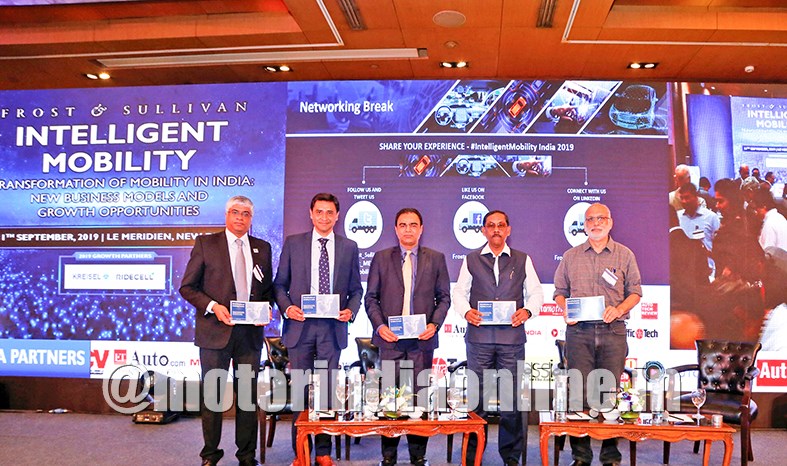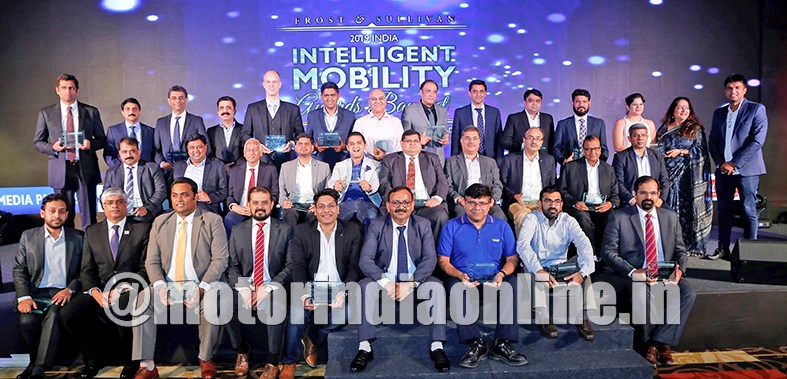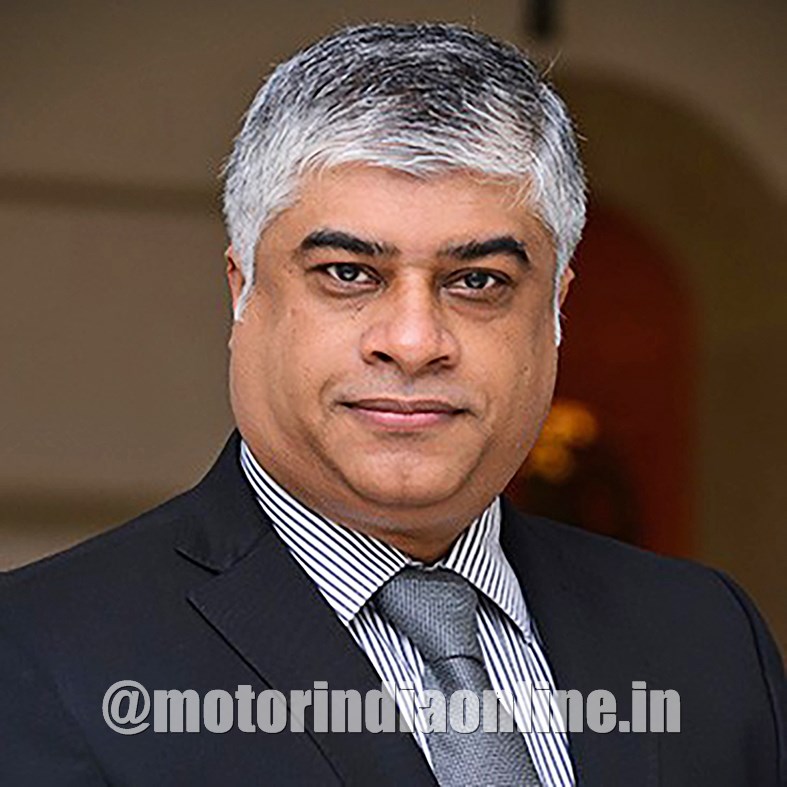At the Frost & Sullivan’s ‘Intelligent Mobility 2019’ summit held in New Delhi, the focus was on how technology is changing the rules of engagement in India’s mobility industry and how this will lead to the future getting defined as much by collaboration as by competition

Frost & Sullivan concluded the inaugural edition of its ‘Intelligent Mobility 2019’ in India on September 11 at New Delhi. The summit brought together leading experts and visionaries to envisage the next wave of innovation emerging in India’s dynamic mobility space. The event kicked off with a power-packed keynote session on ‘The Future of Mobility: Transformational Shifts and Growth Opportunities in India.’ The wide-ranging discussions highlighted the importance of transitioning from traditional linear value chains to interlinked, multi-dimensional value ecosystems, optimising data intelligence, and creating appropriate roadmaps for data monetisation.
While reiterating the need for electric vehicle development, the session also emphasised the need for government and industry stakeholders to work in tandem to boost the entire mobility industry. Talking about the future of mobility in India, Sarwant Singh, Managing Partner, Frost & Sullivan, said: “Much like in the rest of the world, technology has changed the rules of engagement in India’s mobility industry. The future will be defined as much by collaboration as by competition. Stakeholders – private and public, automotive and non-automotive, manufacturers and service providers – have to come together with a common sense of purpose to drive transformative growth, nurture innovation, and create value. A silo approach will no longer work; instead, what the Indian mobility industry needs is to work towards a future that is smart, sustainable, safe and seamless.”
The high-profile speakers at the summit included Pravin Agrawal, Joint Secretary, Department of Heavy Industry, Government of India; Anil Srivastava, Principal Consultant and Mission Director, National Mission on Transformative Mobility and Battery Storage, NITI Aayog; Nikunj Sanghi, Chairman, Automotive Skills Development Council; Nagesh Basavanhalli, Managing Director and CEO, Greaves Cotton Ltd.; Pankaj Jhunja, Head of Mobility Services, Tata Motors; Ramashankar Pandey, Managing Director, Hella India Lighting Ltd.; Kannan Chakravarthy, Head – Smart Sustainable Mobility Solutions, Mahindra and Mahindra Ltd.; Nandini Maheshwari, Head, Business Development, Uber India; and Karan Jain, Co-Founder, REVV.

In his presentation, Pravin Agrawal talked about new business models and the rise of electric mobility in India. He emphasised the potential for retrofitting old models with electric drivelines, developing range extenders, and designing new business models for last-mile connectivity and shared mobility. Anil Srivastava spoke about the importance of multimodal connectivity, the government initiatives being undertaken to create a supportive regulatory and infrastructural environment, and the need to develop mobility technologies suited to the Indian ecosystem. In a special video message, Gautam Hari Singhania, Chairman and Managing Director, Raymond, made a case for reducing the heavy import duties on the niche supercar market.
Bringing up the news blaming the ‘millennial mindset’ for using ride-hailing services such as Ola and Uber being one of the causes for the automobile industry slump in India, Ramashankar Pandey touched upon asset-light ecosystem and the need for collaboration with non-automotive participants. The panel discussions at the summit focused on a range of eclectic themes. These included opportunities for collaborative development of connected, shared and electric markets in India; the potential for partnerships between automotive companies and non-automotive participants in ecosystem development; and vehicle lifecycle management, digital transformation and new business models. The panellists examined how traditional models of purchase and vehicle ownership have ceded ground to subscription-based models and rental or leasing models.
Two key ideas emerged from the discussions on new business models, major trends, best practices, innovative technologies, evolving customer expectations and strategic responses. The first was the need for greater collaboration, cooperation and cohesion across various industries and stakeholders, reinforced by greater private-public sector engagement. The second was the critical need for localisation and personalisation. Elaborating on this, Kaushik Madhavan, President, Mobility Practice, Frost & Sullivan, said: “There has been a paradigm shift in the Indian automotive market. The one-size-fits-all approach is outdated.”
“The future will be about greater localisation predicated on offerings that match particular geographies or local sensibilities. Personalisation will be made possible by artificial intelligence. In the future, differentiation will come from highly individualised services that will not only take the customer experience to a new level but will also create the groundwork for sustainable industry growth,” he added.
The summit was followed by Frost & Sullivan’s 2019 India Intelligent Mobility Awards Banquet, which recognised 29 of India’s leading-edge companies who have demonstrated business innovation and excellence in the mobility space.
“Demand Responsive Transit likely to gain prominence”
In an exclusive interaction with Dhiyanesh Ravichandran at the sidelines of the latest Frost & Sullivan’s Intelligent Mobility Summit, Kaushik Madhavan, the company’s Vice President – Mobility Practice, delineates the future of mobility business models in India in the contexts of private, shared, mass, and freight mobility in the domestic market scenario

What, according to you, are the traits of next-generation mobility that are fast emerging globally and have great relevance to the Indian context?
As we understand from various discussions happening across the globe, new mobility models involving ‘CASE’ – connected, autonomous, shared, and electric – is gaining huge momentum for the future. However, not all four megatrends seem relevant in the Indian context in the short and medium-term. According to me, it’s just the connected vehicles and shared mobility-related business models that will have accelerated adoption in the Indian market scenario in the upcoming years.
With the advent of 5G network connectivity in India, a lot of dynamism is going to be infused into the aspects of shared mobility. The concept of DRT – demand responsive transit – is going to be the future of the mobility market in India. Unlike the present aggregator model which is point-to-point, the DRT systems will not have any fixed routes, and depending on where the demand is, they will be able to cater to those routes or areas dynamically, with real-time intervention and at much cheaper operational costs than today’s shared mobility. Electrified fleets, under DRT systems, will bring down costs even more.
What could be the timeline for such a massive transition in India?
Well, since the connected and shared mobility is already happening, the DRT concept is likely to gain prominence in just 3-4 years from now. The upcoming decade is going to be that of DRT for sure. The trend of electrification of automobiles, by that time, say 2030, is expected to stand at 30% across all passenger vehicle segments at the national level. The two-wheelers and fleet passenger vehicles will have a higher share of EVs, but not so in private car segments.
Is electrification of vehicles a prerequisite to the concept of DRT?
Not necessarily. Right now, most of the DRT models around the world use conventional ICE vehicles. If they are going to be electrified, that will further reduce the cost of travel. Though electrification is not a driving factor for DRT, it will significantly contribute to the economics of operation in the new mobility models.
What is going to be the future of private mobility then?
At least in the short and medium-term, private car consumption is probably going to plateau or go down a bit, but that does not mean the sales of vehicles will wither away; just that the volume sales will shift to shared mobility. The advantage perhaps is that the average lifetime of vehicles in shared mobility is 2-3 years owing to their utilisation levels being much higher than private cars. Thus, from an OEM’s perspective, quicker replacement will push up the overall sales of vehicles in shared mobility. Private ownership, on the other hand, is likely to drop, but vehicle subscription as a business model will emerge in a big way.
What is the future of mass transportation in the country, bus transportation in particular?
With the government’s push towards electrification, a lot of State-run transport corporations are looking to electrify their fleets. It is not happening at a great pace as a lot of us would have wished for, but STUs will still be the first one to adopt electrification as far as buses are concerned. However, a lot is dependent on the charging infrastructure as well. How are they going to adopt the new ecosystem associated with electric buses? I think it’s going to be the combination of fast-charging installed at their depots and battery-swapping. Thus, electrification in bus transport for urban applications is going to be one of the key drivers of change in the next 4-5 years.
With the rapid emergence and expansion of metro train networks in the Indian cities, is there an imminent challenge in road transportation for masses?
Unlikely, because the way I look at it, infrastructure in India is just catching up with the demand and rarely been ahead of demand. Increasing frequency is the biggest challenge for metro networks, and even if we did to the greatest level, it will ease the congestion; no drastic change in road transportation is expected. There will always be a huge chunk of the population left with more than what any metro networks can cater to.
Apart from established business models in shared mobility, how’s the startup ambiance in the country? Are they successful in bringing innovation, while also being able to scale up with ease?
Startups are the key aspects of the emergence of future mobility business models. However, skilling-up is a major challenge for those emerging firms. It requires the right investments, along with right propositions and technological capabilities. Thus, understanding customer concerns and the right value proposition are the key factors to scaling up. And we have seen companies like Ather Energy successfully scaling up in the best possible way. Even if they are successful in bits and pieces, they are a significant part of the industry and continue to inspire others to innovate in terms of mobility.
We see similar kinds of aggregator models catching up in freight mobility as well, especially in trucking. What will be its future considering that freight mobility is not growing in the silo but in consonance with the developments happening in passenger mobility?
Freight mobility is all about efficiency. A lot of new business models are being spoken about globally and in India as well, but even the traditional ‘hub and spoke’ model is very valid in today’s context. Large inter-city hubs are connected through truck trailers and other means, and for last-mile delivery, small commercial vehicles are used. The fact is that SCVs are very relevant for electrification, as that is where OEMs are trying to leverage a huge opportunity. The ICV segments may see growth only for some specific applications, but the combination of diesel-run HCVs and electrified SCVs will define the logistics and delivery models in the days to come.
How prepared are the automotive industry stakeholders for newly-emerging mobility models?
OEMs clearly understand the new mobility business models. But the supplier ecosystem is going to change. The responsibility of designing and developing a product is going to be shared with suppliers as a collaborative development model. The OEMs and Tier I and II will start integrating their services much ahead and the entire product development lifecycle is going to witness a huge change. Developing products that are closer to customer requirements by involving all their supply chain stakeholders will be a key change.
How is the policy scenario in India supporting these kinds of complex and multiple changes?
The policy direction of government is very clear, towards electrification. But the smaller granularities still need to be worked out. For instance, at every industry discussion, a lot of incentives for EVs are being talked about. In my opinion, incentives are good only to kick-start the change, but can never be a long-term proposition. That’s where the lack of clarity is, creating false hopes and confusion for manufacturers and consumers. The messaging has to be very clear. I think it’s just a matter of putting together a defined framework in the right direction, with several ministries coming together along with NITI Aayog.